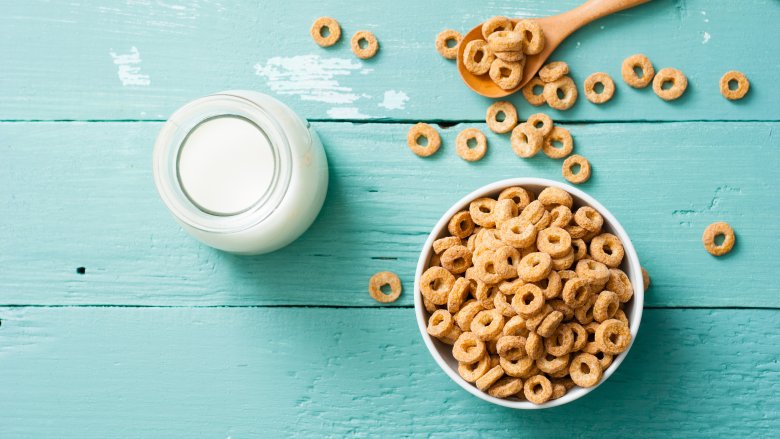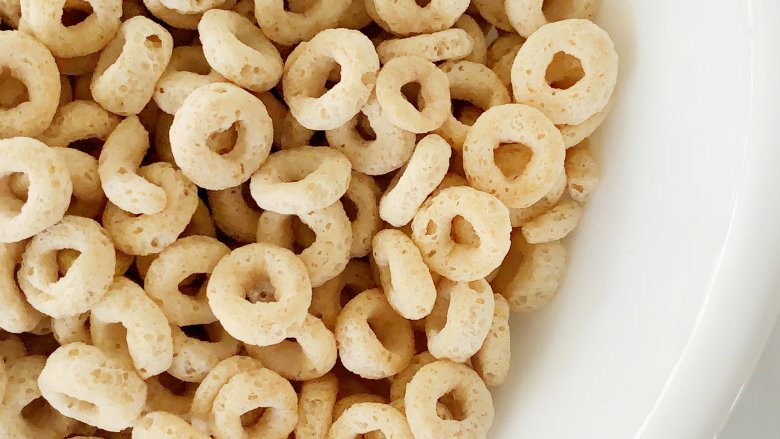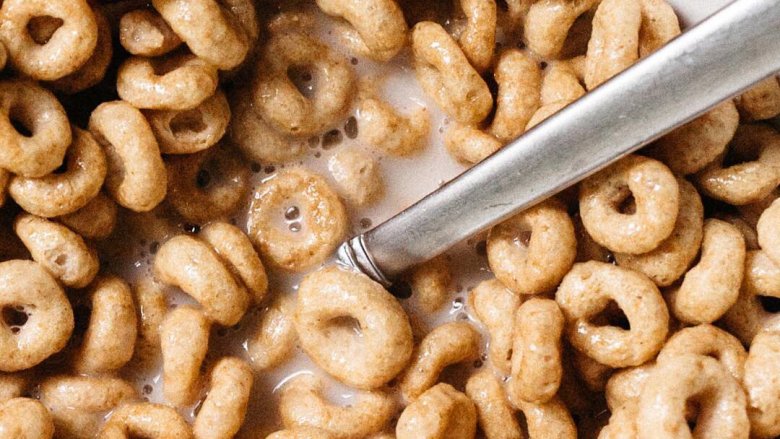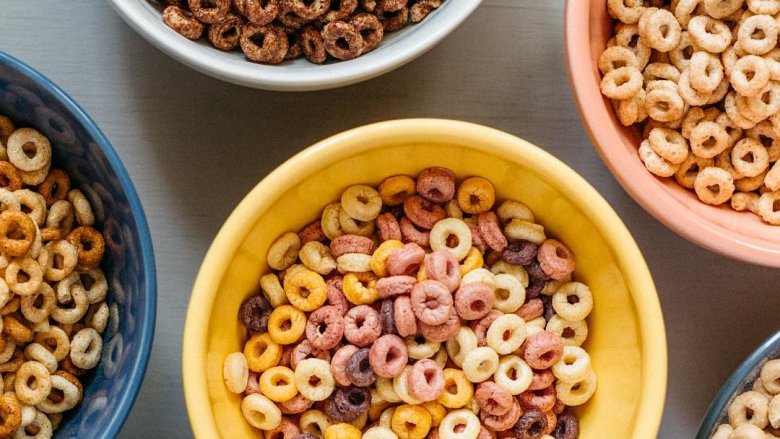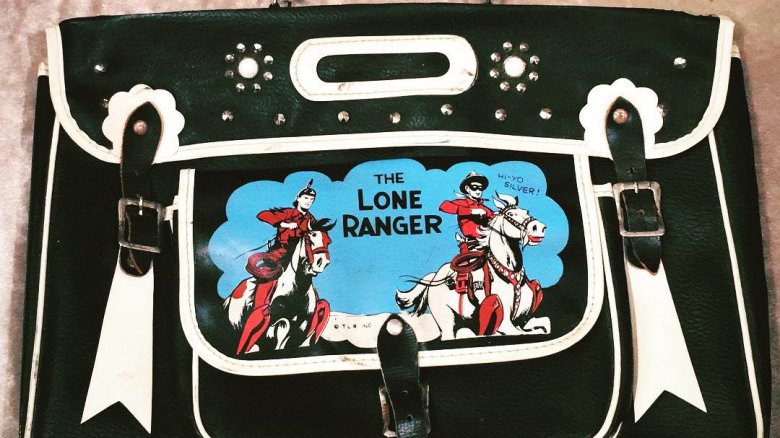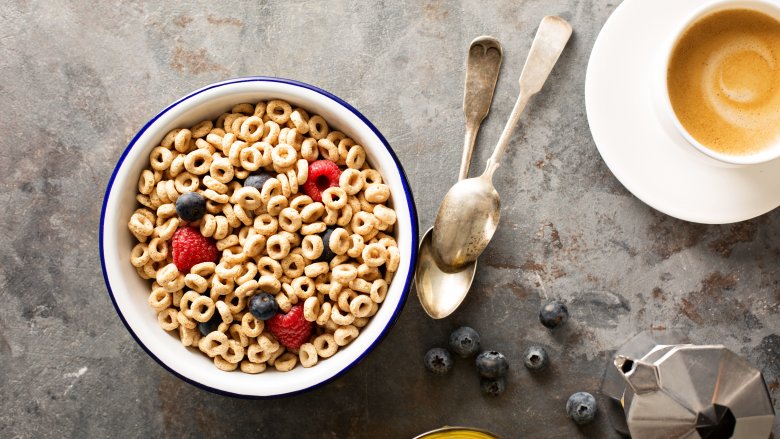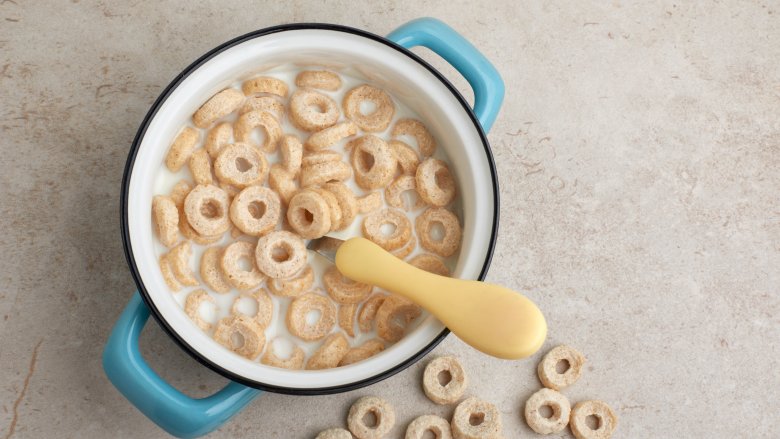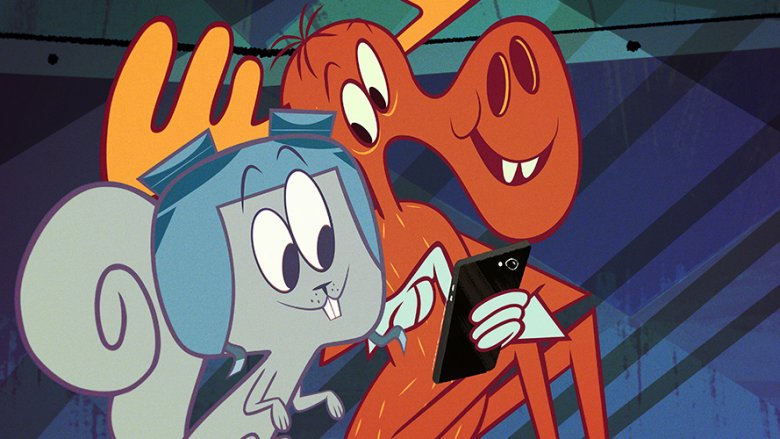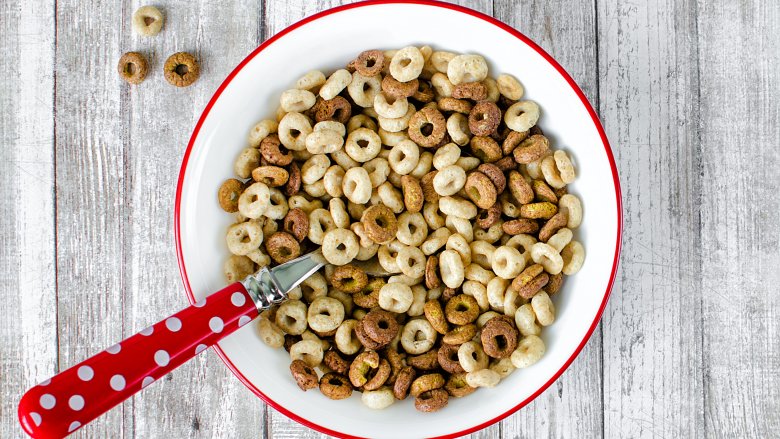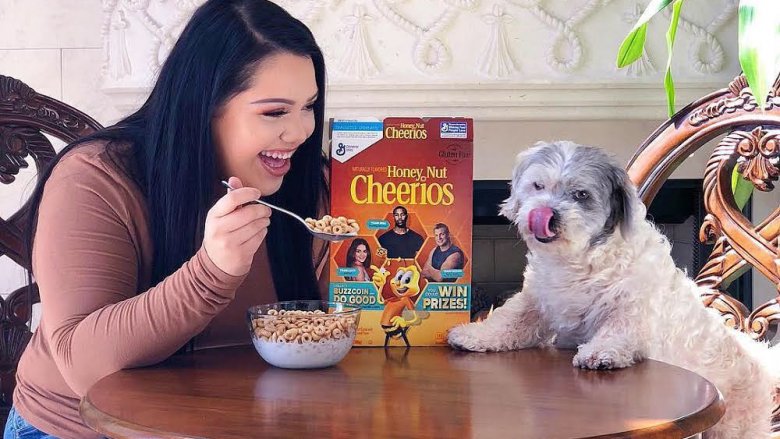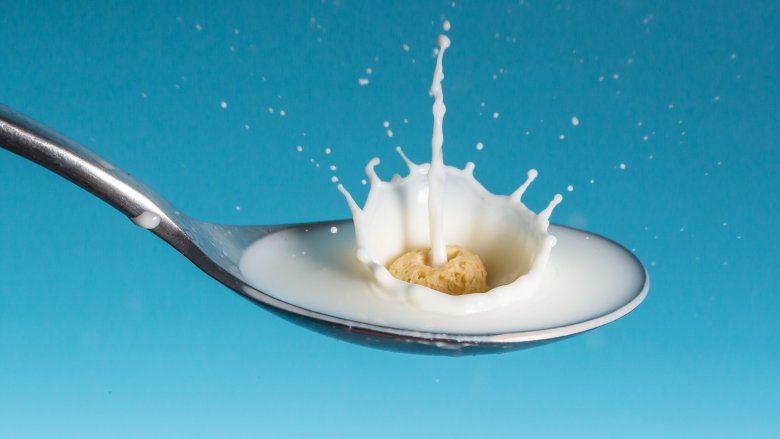The Untold Truth Of Cheerios
If you're like many Americans, you probably don't start the day with an energizing protein drink and a brisk five mile jog through the neighborhood. Instead, chances are good that you make your way to the couch and stare bleary-eyed through half-closed eyelids at the third hour of the Today Show, while you halfheartedly shovel a bowl full of Cheerios into your parched and hungry mouth. And why wouldn't you? They're delicious. And it's better than hitting up the drive-thru window, right?
For almost 75 years, that canary yellow box of Cheerios (and its racier cousin, Honey Nut Cheerios) has been there to help solve our early morning eating conundrums. Because no matter how sleepy you are, how hungover, how emotionally devastated by the profound cosmic unfairness of being expected to show up at work for the third day (in a row!), you can almost always get your act together enough to pour cereal and milk into a bowl. (And if you can't, you've got bigger problems than breakfast.)
Cheerios had a big hand in what we have come to think of as "breakfast cereal," an early-morning staple that changed not just the way we eat, but the way new foods are invented, marketed, and sold. Let's take a look at the untold history of one of American's favorite breakfast cereals, Cheerios.
Cheerios were originally called Cheerioats
If you close your eyes, you can probably imagine the iconic Cheerios logo; it's that ingrained into our consciousness. But did you know that America's favorite cereal originally went by a different name?
When the cereal was invented in 1941, General Mills really wanted to place emphasis on the more healthy, wholesome aspects of its space age new cereal product. They called the tiny rounds of puffed oat "Cheerioats," and rolled the product out to an eager nationwide audience.
There was just one problem: Competing cereal manufacturer Quaker Oats pitched a fit, accusing General Mills of copyright infringement and intentionally causing consumer confusion by using the word "oats," which the rival manufacturer claimed was their exclusive province. Rather than engage in a lengthy court battle over who should be granted the right to use a common English noun, General Mills changed the name of their product from "Cheerioats" to "Cheerios" in 1945, and a legend was born.
The invention touched off an explosion of puffed oat cereal
Before the invention of Cheerios in 1941, the breakfast cereal landscape was much different. Depression-era families were faced with early mornings laden with flavorless, mushy hot cereal that had to be cooked before serving, or a variety of boring corn-based cold cereals, including Wheaties and Corn Flakes, that were anything but exciting.
General Mills changed the business forever, when they tasked physicist and employee Lester Borchardt with inventing a machine that would puff oat dough into a crunchy, ready-to-eat cereal. Borchardt and his team sank countless hours (and dollars) into the new idea, with little in the way of results; at one point, the brass at General Mills even threatened to pull the plug on the whole harebrained idea. But Borchardt knew that he was on to something with this whole "exploded oats" concept, and kept plugging away at his idea until his machine worked. Cheerios were born two months later.
The innovative new technology would lead to an explosion of new cereal releases by General Mills throughout the 1950s and 1960s, including the company's first pre-sweetened cereal, Jets (1953), the multicolored Trix (1954), Cocoa Puffs (1958), and Total (1961).
They were almost star-shaped
The Cheerios shape has achieved icon status in the 74 years since its invention; it's instantly recognizable, and is one of the first foods that babies learn to pick up by themselves. But did you know that when General Mills first developed their oat-puffing machine, there were ten other shapes in the running for Cheerios? It turns out, that familiar donut-shaped "O" wasn't always in the cards; the company also considered spirals, stars, and spheres.
According to Extra Crispy, the team that developed the Cheerio-making machine also experimented with differently shaped dies, in the search for the ideal Cheerios shape, "including a sphere, a six-pointed star, a five-pointed star, a four-pointed star, a three-pointed star, a thin-walled doughnut, a thick-walled doughnut, a dumbbell, a spiral, and a square."
"Results favored the doughnut shape as being the most unique and consistent with good package fill," said Jessica Faucher, corporate archivist for General Mills. "The cereal needed to be light enough to get eight ounces into the package. Also, the doughnut shape proved successful during testing runs when the cereal was being manufactured."
Advertisements of the era touted the unique shape of the product, with one even boasting, "Cheerioats doesn't even look like any breakfast food you ever saw before. We blow it out of guns in the clever shape of little miniature doughnuts... fat and round and toasty-brown."
Cinnamon Nut Cheerios were the first flavor variation
Quick: What was the first flavor of non-Cheerio flavored Cheerio? If you said "Honey Nut," you're probably not alone in that popular guess... but you're also wrong. While Honey Nut Cheerios, the lightly sweetened variety of the classic cereal with hints of honey and almond has been the longest-running flavor, it wasn't the first. That honor goes to "Cinnamon Nut," an early ancestor of Honey Nut that was introduced in 1976 but discontinued after about a year. The salty and sweet balanced perfection of Honey Nut Cheerios was introduced three years later, and it's still a giant hit.
Fast forward to present day, and there are nearly 20 different flavors of Cheerios available, including Frosted, Apple Cinnamon, Fruity, and Banana Nut, as well as the limited time and seasonal offerings that see regional sales, such as Dulce de Leche, Pumpkin Spice, or Chocolate Peanut Butter. But by a wide margin, the original version of Cheerios still outsells them all, making it the number one cereal in America; General Mills sold more than 139 million boxes of their original recipe in 2018, netting the company almost $436 million dollars. Honey Nut Cheerios were a close second, with 129 million boxes sold, totaling $421 million in sales.
Cheerios were cross-marketing pioneers
It's hard to imagine it now, but in the middle of the 20th century, the idea of "cross-promotion," or using one product to sell another, was still fairly new. General Mills changed that forever, with its aggressive marketing of Cheerios, a cereal that required new energy and new ideas for advertising since the product shots of the cereal itself were, well, kinda boring.
In the 1940s, General Mills began sponsoring a radio show targeted toward children, that delivered a strong moral message at the conclusion of each episode. At that time, the creator of "The Lone Ranger" was also looking for a sponsor to help bring their popular radio show into nationwide syndication in 1949. General Mills signed on, and the association between the serialized cowboy and the breakfast cereal continued to drive strong sales for the brand for almost 20 years.
General Mills took the concept of cross-promotion a step further, with their realization that all of those big boxes of cereal could contain more than just dry cereal. In the late 1940s and 1950s, General Mills co-branded boxes of Cheerios with Disney to offer exclusive discounts on comic books, and advertised the newly launched Mickey Mouse Club in the late 1950s.
Cheerios were the first cereal marketed as a snack
We all know that a sugary bowl of cereal isn't just for breakfast; it can be enjoyed morning, noon, and even in the middle of the night — with or without milk. But believe it or not, General Mills was the first cereal manufacturer to actually promote their product not just for breakfast, but for all-day snacking.
In 1941, "Cheerioats" was marketed under the slogan "Makes delicious munching," which marked the first time cold cereal had been promoted as a snack in this way. General Mills pushed the concept even further during World War II in 1943, when the company supplied Cheerioats to the military in 10-ounce "Yank packs," using the slogan "He's feeling his Cheerioats," and suggesting that even men tasked with the arduous business of killing Nazis deserved a few moments to enjoy some toasted oats.
The idea that breakfast could be an "anytime" snack took hold; today, you'll find cereal in salty snack mixes, baked into dessert bars, and included as a side dish in brown bag lunches nationwide.
Before the bee, there was Cheeri O'Leary
When you think of breakfast cereal mascots, you probably imagine the Honey Nut Cheerios bee buzzing around obnoxiously, hysterically imploring children to eat Cheerios as "part of a complete breakfast" that also includes orange juice, toast, milk, scrambled eggs, peanut butter, a few strips of bacon, and maybe a Flintstones Chewable or two. But Buzz the Bee wasn't the first mascot to grace a box of Cheerios; that honor falls to "Cheeri O'Leary," the bonnet-bedecked (and presumably Irish?) little girl invented to help sell the cereal to hungry kids nationwide. Cheeri's infectious sunny smile implored kids in the early 1940s to stop saying, "Good morning," and instead "Say Cheerioats," but that never really caught on, especially once the cereal changed its name to "Cheerios," and probably because the phrase "Say Cheerioats" doesn't actually have any meaning.
Cheeri O'Leary was eventually retired, in favor of Cheerio's new mascot team, "The Cheerios Kid and Sue," who starred in a series of television commercials urging kids to connect the "Big G and the Little O" to get the "GO" power of Cheerios.
Rocky and Bullwinkle appeared in ads in the 1960s
Children's television commercials may have reached their artistic peak in the 1960s, when instead of shouty, zero-attention span quick-cuts of dead-eyed plastic unicorns that poop glitter slime when you squeeze them, kids were treated to full 30-90 second beautifully animated narratives that told a complete story using their favorite characters.
In the 1960s, America's favorite squirrel and moose team, Rocky and Bullwinkle, starred in a series of animated commercials for Cheerios, though poor Bullwinkle usually ended up doing the bulk of the heavy-lifting. The duo often teamed up with The Cheerios Kid and Sue, to learn how Cheerios could help children navigate potentially dangerous situations including "swimming at the municipal pool," or "playing badminton" without the fortifying strength of a protein-packed healthy breakfast. Spoiler alert: they can't.
Other animated characters were soon to follow the success of the Rocky and Bullwinkle campaigns, including Tennessee Tuxedo & Chumley and Hoppity Hooper, a naive animated frog who dressed like a Chippendales dancer and who was always being taken advantage of, thanks no doubt to a lack of Cheerios in his diet.
Cheerios get their signature flavor from double-toasting
Cheerios have a unique, toasty crunch that's unlike any other flavor dreamed up by science, before or since their invention; they manage to be slightly salty and slightly sweet, with tons of flavor from the toasted oats coming through in each satisfying crunch. But what gives Cheerios that distinctive flavor, that's unlike anything else on planet Earth?
Cheerios are manufactured using a unique "double toasting" process, wherein the raw ingredients are toasted separately from the finished, ready-to-extrude dough. "After they've been harvested and sifted, we toast the oat grains, which makes for rich, aromatic oat flour," say the experts at Cheerios. "After the oat flour is made into dough and shaped into O's, we toast the O's again to get that perfectly crunchy Cheerio texture. Our double toasting allows us to bring out the full flavor of each and every oat."
The next time you dive into a bowl (or let's face it, a grubby fistful) of Cheerios, imagine all of the toasting those little O's went through, prior to landing at your breakfast table.
Cheerios are GMO-free and gluten-free
As cereal sales were flagging across all product lines in 2015, with a millennial aversion to the hard work of cleaning up dirty cereal bowls partly to blame, General Mills was looking for new ways to make their iconic cereal relevant for modern consumers. That's why in 2015, General Mills rolled out changes to five of its Cheerios brands, including Original, Honey Nut, Multi-Grain, Frosted, and Apple Cinnamon, making them truly gluten-free for the first time ever.
While whole oats are naturally gluten-free, Cheerios previously contained trace amounts of wheat, barley, and rye, which contain trace amounts of gluten. However, in a post on the General Mills blog, the company announced that they had "developed a way — years in the making — to sort out the small amount of wheat, rye and barley in our supply of whole oats that are inadvertently introduced at the farms where the oats were grown, or during transportation of the whole oats to the mill."
The move to a gluten-free product wasn't the first big news for the company, in its desire to appeal to food-conscious consumers. The company also pledged its dedication to the elimination of genetically modified ingredients in 2014, a claim that's short on substance (since it required very minimal changes to their ingredients) but which contains the buzzwords that consumers love.
There's a city in New York that smells like Cheerios
No matter how much you may think you love Cheerios, ask yourself: Would you want to live in town that smelled like them, all of the time?
In Buffalo, the General Mills manufacturing plants cranks out millions of Cheerios per year. And when the Cheerios are baking, residents in this upstate city in New York know it; the entire region is blanketed in the warm, sweet smell of freshly-baking cupcakes, with just a hint of oats, turning the city into a gigantic version of an afternoon at Grandma's house.
While some citizens are no doubt bothered by the aroma, at least one journalist is campaigning for Buffalo to embrace its sweet scent, writing, "Why doesn't the city market this? ... For a place known for chicken wings, manufacturing, and the assassination of a U.S. President, it's not so far-fetched to use 'Cheerios smell' for the betterment of the city's image."
Sounds like one more reason to book a flight to Buffalo, stat.
The FDA nailed General Mills for making misleading claims
The Cheerios marketing team has been trying to link their cereal with a healthy diet since it was introduced, and commercials in the 1950s promised that eating Cheerios would promote "healthy nerves" and "good red blood."
But the company may have gotten a little carried away in the late 2000s, when a series of marketing claims landed the company in hot water with the Food and Drug Administration.
Cheerios claimed that switching to the cereal for breakfast could reduce "bad" cholesterol levels by four percent in just six weeks, and would prevent heart disease and cancers of the colon and stomach. These claims were present the product's packaging, website, and were even announced in supermarkets.
The FDA had claimed in broader terms that a diet low in saturated fat and cholesterol, and high in fiber, may help reduce the risk of heart disease. But a Cheerios diet was never mentioned specifically by the FDA, and Cheerios included the prevention of diseases they hadn't mentioned, and failed to include the rest of the FDA's recommended diet changes. It was an incomplete message at best.
The FDA clapback came swiftly. The agency served General Mills with a letter informing the company that its claims about the health benefits of eating Cheerios "would cause it to be a drug because the product is intended for use in the prevention, mitigation and treatment of disease."
The letter went on to helpfully explain to Cheerios that Cheerios are not a drug, and as such, the claims that the cereal lowered cholesterol and reduced the risk of heart disease and cancer were in violation of federal law. They were given 15 days to remove the claims from their packaging.
